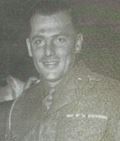Fred died on 23 September 2000 aged 78.

He enlisted in London on 13 October 1916 as a Band Boy.
He was attached to the 3rd King’s Own Hussars prior to joining the 13th/18th Hussars in India in January 1938. He returned to the UK in November 1938 and joined 53rd Training Regiment, subsequently, he moved between various training establishments until joining the 2nd Royal Gloucester’s Hussars on 27 May 1942. He had joined Man’s service on 2 February 1940 and had been promoted to Lance Corporal in November 1940 and to Corporal in December 1940.
He moved to the Middle East on draft to the 2nd Royal Gloucester Hussars in January 1942, joining them in March 1942 and becoming a member of ‘F’ Squadron. He was captured at the battle of Bie El Harmat on 27 May 1942 while trying to save his troop leader. He subsequently spent time in prisoner-of-war camps in Italy and Germany.
He was repatriated to the UK in April 1945. Between then and joining the 8th King’s Royal Irish Hussars in February 1946 at Itzehoe, he served in the 54 Training Regiment, during which he married Kay at Doncaster on 12 January 1946. Within a year David was born, to be followed by three sisters and a brother. In July the 8th Hussars moved into quarters and shortly afterwards Fred was introduced to the many aspects of the Sergeants’ Mess.
He was promoted to Sergeant in December 1946. In February 1948 the Regiment returned to the UK (Leicester East Airfield). He was captain of the Regimental team, which competed at Bisley in 1949 winning the Cambridge Shield – the first time since 1908 the Regiment had won it. He was a member of ‘B’ Squadron and moved with them as troop sergeant/radio instructor in October 1949 to the School of Infantry, Warminster, where they were the demonstration squadron.
On 11 October 1950, he sailed with the 8th Hussars, from Southampton, on the Empire Fowey for Pusan (Korea). He was ‘B’ Squadron signal Sergeant.
On 10 November 1951, he flew back to the UK, going on leave prior to joining the advance party at Luneburg. He arrived in 1952 and joined the Quartermaster’s department as families SQMS. Luneburg on 6 March 1952. He was promoted to SQMS in April.
In September 1953 he was promoted to Warrant Officer class two and returned to ‘B’ Squadron as SSM. In February 1954 he was appointed RQMS of the 8th Hussars. Unfortunately, he did not join the amalgamated regiment the Queen’s Royal Irish Hussars. He filled an ERE appointment in the Kiel Yacht club.
He remained there until being commissioned on 14 September 1959 into the 15th/19th King’s Hussars where Fred took up the appointment of Technical Quartermaster. The Regiment was then stationed at Barnard Castle.
He moved with the Regiment to Münster (BAOR) in August 1961. During this time he was appointed Regimental Quartermaster. In January 1968 he with the Regiment returned to the UK, Tidworth.
The 15th/19th King’s Hussars returned to (BAOR), Fallingbostel in November 1969. Fred, now a major, left the Regiment in May 1970 and spent a few weeks on the strength of RAC Centre Bovington, before proceeding to Singapore to take up the appointment of Quartermaster HQ Sembawang Garrison. He closed down the Garrison and returned to the UK in February 1973. He became a Member of the British Empire for his part in the closing down of the British presence in Sembawang.
In June 1973 he assumed his final appointment as Adjutant and Quartermaster of Bristol University OTC.
He retired in March 1977 as a Lieutenant Colonel. Not bad for a soldier who had started his military career as a Band Boy in 1936.
He was a splendid soldier and sportsman, a great administrator, a good friend and an invaluable help to the writer of this obituary when he was a young headstrong NCO, working for Fred, who was the RQMS in the Quartermaster’s department on the 8th Kings Royal Irish Hussars.


